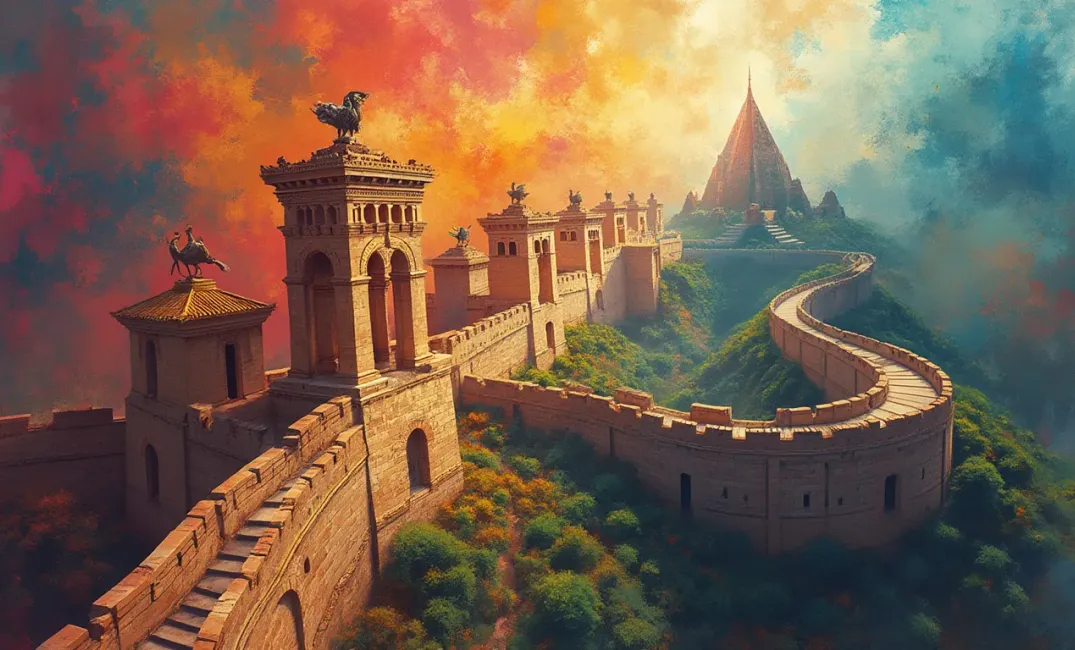Introduction: The Tides of Power Across Ages
"Empires rise and fall, titans of civilization's grand narrative, leaving indelible marks on the landscapes of history and legacy." — Unknown
Throughout history, empires have emerged as monumental structures of power and intellect, transcending borders and shaping human civilization in their wake. These thundering giants, born from wars, diplomacy, and ambition, painted the complex tableau of human history, driving advancements and cultural exchanges while leaving lasting impressions through their rise, expansion, and inevitable fall. The human journey through empire-building offers lessons on governance, resilience, adaptation, and the inexorable quest for legacy—a saga echoing through the corridors of time.
The Dawn of Empires: From Tribal Lands to Kingdoms
The Genesis of Power
- Tribal Societies to Kingdoms: Human societies began as small, cohesive tribal communities, bound by kinship and shared resources. Over time, settlements matured into structured kingdoms governed by rulers who oversaw territorial and resource management, sowing seeds for future empires.
- Domestication and Agriculture: The Agricultural Revolution was a cornerstone that enabled population growth and movements toward urbanization. The ensuing stability enabled societal diversification, political centralization, and technological innovations that fuelled expansion and control.
The First Empires in History
- Sumerians and Akkadians: Mesopotamia, the cradle of civilization, hosts the rise of the Sumerians with city-states like Ur and Uruk. The Akkadian Empire, under Sargon the Great, unified these territories to form arguably the first empire by conquering vast tracts of the Fertile Crescent.
- Ancient Egypt's Dynasties: The unification of Upper and Lower Egypt marked the formation of another pivotal ancient empire. Pharaohs like Ramses II expanded power through military conquests and diplomatic treaties, with grand architectural legacies such as pyramids standing as emblematic traces of their formidable society.
Expansion and Golden Ages: Zeniths of Civilization
Majestic Powers of Antiquity
- The Roman Empire: Renowned for its legal systems, architectural marvels, and formidable military, Rome epitomized imperial grandeur. Rome's adaptability—from Republic to Empire—allowed it to govern territories spanning three continents, embedding a legacy of governance, law, and classical culture.
- Han Dynasty China: The Han Dynasty epitomized Chinese excellence in warfare, agriculture, and trade. It cultivated intellectual strides in science and technology, laying foundational philosophies like Confucianism that continue to influence East Asian cultures. The Silk Road flourished, binding China to distant Rome in an emerging global exchange.
Cultural and Technological Flourishing
- Byzantine and Sassanian Empires: Successors to Roman and Persian legacies, respectively, the Byzantine and Sassanian Empires preserved and advanced much of the ancient world's knowledge and traditions. Byzantine art and architecture thrived, and the Code of Justinian laid the groundwork for many legal systems. In Sassanian Persia, engineering marvels complemented flourishing literature and art, fueling regional power.
- Mughal Empire: Bridging the traditions of India and Persia, the Mughal Empire in India became a beacon of culture and architecture, with emperors like Akbar heralding an era of tolerance and flourishing arts, while Shah Jahan left the world marvelling at the beauty of the Taj Mahal.
The Dynamics of Conquest: Strategies, Diplomacy, and Adaptation
Expanding Frontiers
- Mongol Empire: Under Genghis Khan, the Mongol Empire became the largest contiguous land empire in history. Utilizing cavalry and innovative tactics, the Mongols conquered vast territories, from Eastern Europe to Korea, establishing trade and communication networks across Asia through the Pax Mongolica.
- Ottoman Empire: Rising from Anatolian roots, the Ottomans expanded through strategic conquest combined with diplomacy and innovative governance, maintaining diverse populations while harmonizing various ethnic and religious groups under equitable rule.
Governance and Integration
- Colonial Empires: Western European powers, from the Spanish Empire to the British Empire, pursued global dominance through maritime exploration and colonial expansion. This era reshaped the globe, introducing new technologies, cultivation methods, and cultural exchanges, while igniting ethical debates over colonial exploitation and independence.
- Incan Empire: In South America, the Incas built a sophisticated and integrated empire leveraging vast road networks and advanced agricultural terraces despite geographically challenging terrains. Adaptation and administration through an efficient system allowed the Incan Empire to flourish, leaving structural and cultural imprints still commemorated today.
The Legacy of Empires: Downfalls and Reverberations
Decline and Fall: The Inevitable Collapse
- Economic and Political Overreach: Many empires succumbed to overexpansion, which strained resources and provoked internal divisions. Military overstretch, economic dependence on conquest, and political fragmentation often precipitated decline, as seen in the Roman and Abbasid Empires.
- Invaders and External Pressures: External forces including barbarian invasions, nomadic incursions, or competing empires contributed to imperial collapses. The fall of Constantinople to the Ottoman forces marked the Eastern Roman Empire's end, striking a significant historical transition point.
Enduring Impacts and Lessons
- Cultural Syncretism and Legacies: Despite declines, empires left lasting legacies in language, law, and religion. Their cultural syncretism promoted rich fusions seen in languages like Latin transforming into the Romance languages or the spread of Buddhism across Asia.
- Political Heritage and Identity: Imperial legacies continue to shape national identities and governance models, from classical democratic inspirations in modern republics to culturally-rooted identity resistance influencing independence movements against European colonial powers.
Conclusion: The Echoing Lessons and Prospects of Empires
"To whom much is given, much is expected." — Traditional Wisdom
Empires as architects of history have wielded power to craft, expand, and connect civilizations through time. Each empire, a chapter in humanity's enduring book—a saga dotted with tales of valor, intellect, ambition, and folly—unveils the complexities of human societies.
The rise, reign, and fall of empires underlie perpetual lessons in governance, illustrating the balance of power, responsibility, and the fragility of ambition. As humankind voyages into cosmic frontiers, those echoes—of both their glories and their cautionary tales—fuel aspirations towards inclusive and mindful expansion.
Let the annals of empire-building inspire steadfast dedication to knowledge, justice, and unity—a beacon to guide humanity toward new horizons while paying homage to the resilient legacies carved into history's grand tapestry. Through discerning historical introspection, we honor the past while shaping a future that cherishes shared potential and celebrates the diversity of purpose beyond empires untold.
GLOBALIZATION, CULTURAL EXCHANGE, EMPIRES, GOVERNANCE, ECONOMY, LEGACY, HISTORY

